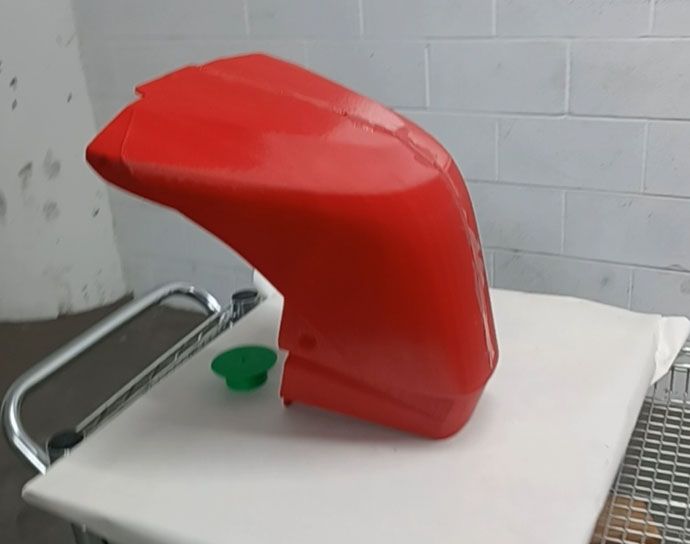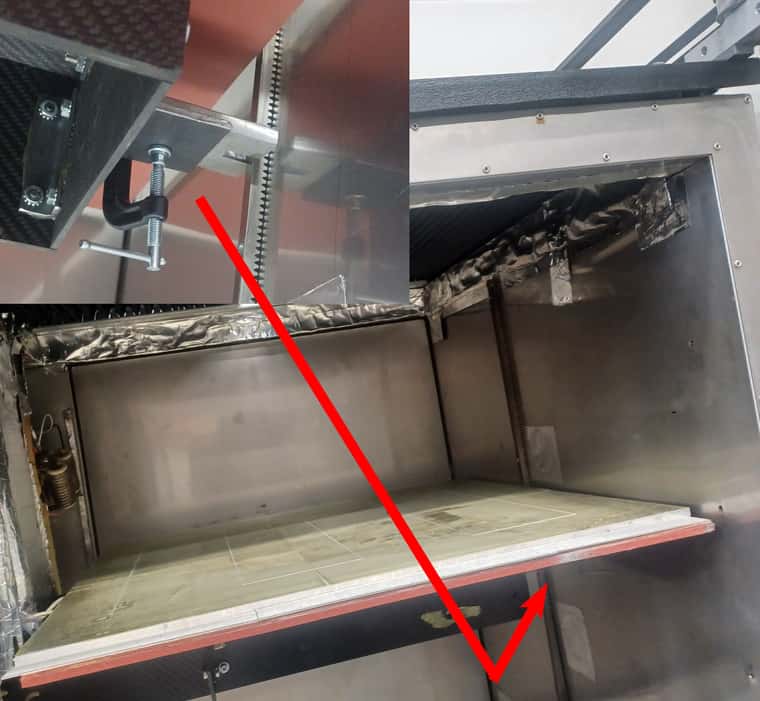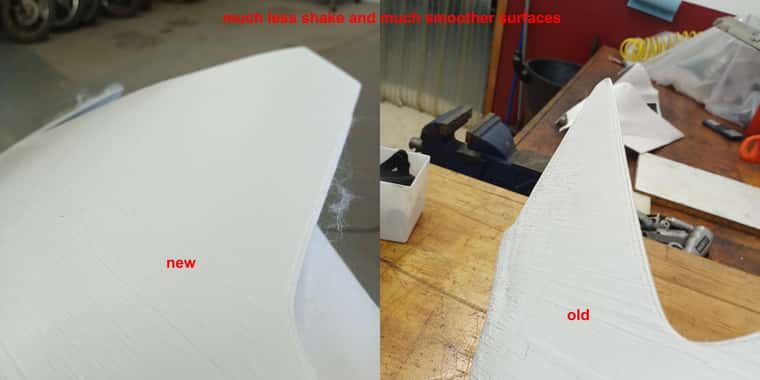New heated enclosure printer
-
@coseng Try printing in wider lines and thinner layers. Prusa slicer will automatically adjust layer thickness based on overhang angle/detail (I think) if you enable it.
-
@mrehorstdmd said in New heated enclosure printer:
@coseng Try printing in wider lines and thinner layers. Prusa slicer will automatically adjust layer thickness based on overhang angle/detail (I think) if you enable it.
Hmm, so you think the bead is falling off the edge of the part before adhering? I am printing the outer wall last to try to prevent that and this part has 3 walls. It is small enough to test with and I can cut off the lower section to get right to the problem area. Maybe higher print temp too to make the bead 'stickier'?
-
@coseng Not quite ideal, but I've set Cura up such that when a third tool is enabled (and of course selected to print the model with - get the right tool-changes in RRF), the machine disallowed area (preview) represents the printable area of half my build plate.
https://forum.duet3d.com/topic/13696/new-large-format-idex-printer-project/22
https://www.youtube.com/watch?v=z_CbTmiBqswI say not ideal, as the way I structured this approach is 'if the number of active extruders is greater than 2, limit my print area to this width'.
"machine_disallowed_areas": { "value": "[ [ [0, -237.5], [0, 237.5], [225, 237.5], [225, -237.5] ] ] if len(extruderValues('extruder_nr')) > 2 else []"}A better approach, but one I couldn't get to work, would have been 'if extruder 3 is selected, limit my print area to this width'. One of these days I'd like to take a look at the inner workings of the various BCN3D forks of Cura (their old Cura, and their new Stratos) and see how they handle the machine disallowed area. They allow you to select a print mode (like a Cura quality/nozzle selection), which injects the mirror/duplication GCODE into the preamble of the print file.
-
@sebkritikel said in New heated enclosure printer:
Not quite ideal.......
Found this online which says IDEX support so will give it a try:
https://www.bcn3d.com/bcn3d-stratos/
https://support.bcn3d.com/knowledge/bcn3d-stratos-introductionIt is based on Cura so the settings should be familiar, and interestingly enough found a post online relating to native Cura IDEX support:
-
@coseng If you want to go further down the rabbit hole, some other discussions I had on a user in regards to BCN3D's forks (and slicer/IDEX compatibility in general):
https://forum.duet3d.com/topic/19167/creating-a-new-idex-3d-printer-with-duet-2-wifi/31?_=1670003869964 -
@sebkritikel A rabbit hole is exactly what I am trying to avoid!
 Didn't see that Merlin firmware part, maybe they've made progress in the past year or 2?
Didn't see that Merlin firmware part, maybe they've made progress in the past year or 2? -
Hmm, IDEX is not as plug and play as I was hoping!
An alternate solution is to repurpose the extra UV Clearpath motors and build a CNC plasma cutter with them. They are more than strong enough to push a plasma gantry around pretty quickly and from what I can see with some friends that purchased stepper based tables, unless you spend well into the $10ks, the Duet control board seems to be a step up, and the Clearpath motors are two steps up! A 4'x4' CoreXY cutter would be pretty useful and more rigid than most of the table setups I see out there.
@dc42 , I saw some older threads about it but there never seemed to be any final results. Did you end up doing those software modifications you were talking about for the torch height control?
https://forum.duet3d.com/topic/8403/advice-on-adding-plasma-torch-height-control/10
@fall-apart-dave @mawildoer @andymidtf
Did any of you ever make it to a working Duet-based machine? -
With this cold weather we're having my big industrial space is at least 15F colder than it was in spring/summer and the machine is misbehaving a bit. After a bunch of heater errors I had to rerun the heater optimization routines and think the bed 'shape' is a bit off as I am having first layer adhesion problems, but only on the corner of a big part. The first layer extrusion is mostly flat but is roundish where it is not adhering, so think the bed is drooping a bit. My bltouch is fried so I have been manually setting Z, but am not sure about the heightmap file format. I can use a plunge indicator mounted to the carriage to accurately map out the bed, but am not sure how the file entries are mapped to the bed.
For the heightmap file below are the matrix entries, does the first entry of -.094 correspond to (maxX, maxY) or (minX, MinY)? Are rows X and columns Y? Does a negative value mean the print is closer or further from the printhead?
RepRapFirmware height map file v2 generated at 2017-07-21 20:53,
axis0,axis1,min0,max0,min1,max1,radius,spacing0,spacing1,num0,num1
X,Y,-310.00,315.00,-288.00,288.00,-1.00,156.25,288.00,5,3
-0.094, -0.047, -.020, -0.127, -0.18
-0.094, -0.047, -.020, -0.127, -0.18
-0.094, -0.07, -.010, -0.127, -0.18
-0.10, -0.07, 0.000, -0.127, -0.18
-0.10, -0.09, 0.010, -0.127, -0.2Thanks.
-
@coseng each row is a set of X points from min to max. The first row is min Y, the last is max Y.
-
@dc42 Thanks!
-
It's been a while, the printer has been working well, but am about to do another run of fairings so am going to try to improve it a bit.
There is some waviness to tall and slender parts that increases as the parts get slimmer and taller in Z. Looking at it while printing, it seems that my construction of a carbon fiber Z carriage works against me in one way. I used high temp CF for its rigidity and low thermal expansion and high enough temp rating. This means that my Z carriage is pretty light, and at high printhead accelerations, can see a slight bit of movement that comes from not enough torsional stiffness of my z-axis rail/leadscrew wended frame. 20+ inch parts can get a visible wiggle at the top as the vibrations die down. I am not interested in tearing it all apart and having to do welding and realignment/reassembly, so am going to try to take the easy way out by putting a large steel weight on the bottom of the z carriage. A heavier carriage means less reaction displacement for a given printhead acceleration, hopefully stabilizing it and reducing the waviness. It is an easily done and undone modification, so pretty low risk.
The waviness I am getting is not stepper induced oscillations as I am using servo/steppers which are silent and smooth.
-
Well, the added weight to the Z carriage seems to have reduced the oscillations a bit which is great.
I am a bit under the gun for our next race outing in October, so looked to outsource some of the fairing parts. So far, 4 out of 4 vendors have refused a quote as the parts are too thin and difficult! They all recommended sectioning them into multiple pieces and gluing together. When I said that the parts have been printed successfully multiple times in one piece on a home built printer, they were very surprised.
On one hand those responses were pretty disappointing. I was expecting that industrial printers would be a step above what I hacked together. They are not. On the other hand it speaks volumes to the quality of product that Duet3D sells and the support from them and other users that is provided on this forum. Many thanks to everyone that has chimed in along the way, @dc42 and @mrehorstdmd in particular.
I've also recently printed a few big, chunky parts that came out excellent with none of the artifacts the tall, thin fairing parts have. I guess I will focus more on bracing for the fairing parts to keep them from shaking during printing. Maybe more retracts will help too. I do notice a little noise when it is doing the infill, which is assume is the printhead hitting slightly high areas of the previous layer. I am also having some issues with the fill areas on the first couple of layers looking really fuzzy, which I think is over extrusion, but I reduce the flow down to about 70% and it looks the same. The parts come out fine and I am still time constrained, so am kicking that can well down the road.
This is a pattern for a carbon fiber gas tank. Printed in two halves and glued together. About 3.5 gallon capacity. There was a slight bit of the print rising up from the build plate, but nothing major and easily taken care of when it is sanded and bondo'd to get a good surface finish to take a mold from. Also doing a mold for a bellypan that is coming out just as good.

-
I am going to print another set of bodywork and finish it out for a nice high gloss paint job but wanted to get some better surface finish to minimize the amount of hand finishing needed. The added weight did help, but in reality my Z axis support structure was lacking in torsinoal stiffness. I didn't think that there would be a need for high torsional stiffness, but I was wrong. As the printhead traverses back and forth over the part sometimes it slightly makes contact with previously printed material and causes the table to wobble back and forth.
To fix this, I added an outboard table guide that is just a long straight piece of steel that a forked steel guide finger that bolts to the carriage engages with.
That is a gear rack, but I only used it because it was ground straight and flat and was available. Moral of the story, design sufficiently rigid structures!
It is a bit of a kludge, but it does work and significantly increases the torsional stiffness of the Z-axis. The parts did come out noticable better, especially the taller areas.

As an additional note, we are using the Smooth-On XTC-3D product and am finding it works very well.
-
With the rework on the carriage I needed to redo the mesh compensation but am having problems loading heightmap.xls. I am using the G29 S1 command and getting the following console error:
G29 S1
Error: G29: Failed to load height map from file 0:/sys/heightmap.csv: bad header line or wrong version headerThis is the heightmap file:
RepRapFirmware height map file v3 generated at 2017-07-21 20:53,
axis0,axis1,min0,max0,min1,max1,radius,spacing0,spacing1,num0,num1
X,Y,-310.00,315.00,-288.00,288.00,-1.00,156.25,144,5,5
-0.46, -0.4, -.32, -0.25, 0.08
-0.3, -0.25, -.2, 0., 0.1
-0.02, 0.02, 0., 0., 0.02
-0.3, -0.3, -0.25, -0.3, -0.35
-.35, -0.36, -0.35, -.4, -.5I used to get the warning saying that it was loaded with Z not at zero so may be some offset, but it always worked. With this new error it is not loading at all. I didn't think i had changed anything in the heightmap file except the offset values. None of my older heightmaps load either, they all give the above error.
I am using Duet Web Control 3.4.1 and the printer is a Duet 3 MB6HC (MB6HC) with 3.4.1 Firmware.
Also, @dc42 is a negative value the bed being closer or further from the nozzle?
Thanks,
-
@coseng The heightmap should be v2, not v3, in the header. Did you change that manually? For example, mine is:
RepRapFirmware height map file v2 generated at 2024-03-27 21:04, min error -0.091, max error 0.109, mean 0.004, deviation 0.056 axis0,axis1,min0,max0,min1,max1,radius,spacing0,spacing1,num0,num1 X,Y,-85.00,85.00,-85.00,85.00,-1.00,42.50,42.50,5,5 0, -0.048, -0.091, -0.077, 0.031 0, -0.074, -0.058, -0.037, 0.014 -0.022, -0.007, -0.007, 0.022, 0.072 0.002, 0.018, 0.071, -0.022, 0.109 0, 0.089, 0.083, 0.049, -0.026You can always delete the heightmap.csv, and run bed mesh again.
A negative value is the bed being further from the nozzle.
Ian
-
@droftarts Wow, i feel stupid! I don't remember changing it but must have as it now loads. Thanks!
-
Hi all, I've come to a crossroads in life and my bike project is being shut down. As a result, all of my equipment is up for sale, including this 3D printer.
The print volume is 680x624x920mm and it is set up to use 1, 3, or 10kg spools from pushplastic.com It should be easy to make adapters to use any other spools less than 10kg in size.
If anyone is interested, please browse through this thread which thoroughly details its components and printing ability.
For more information please contact Ben Claman, ben@buoyant.aero.
Thanks again to Duet3D and this forum for all the help in getting this beast to print well.
Chris Cosentino
Cosentino Engineering -
@coseng I'm sorry to hear that your project is shutting down. I suggest you post in a new thread with "For sale" in the title and give the machine specifications and your location in that post.
-
@dc42 Will do, thanks.
Chris Cosentino
Cosentino Engineering -
 undefined coseng referenced this topic
undefined coseng referenced this topic